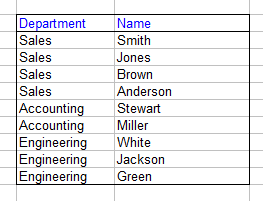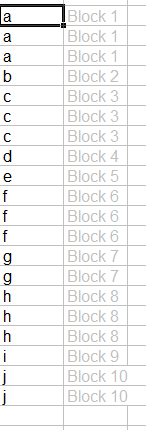 Data Blocks On Worksheets
Data Blocks On Worksheets
This page describes VBA code for working with blocks of data on a worksheet.

It is very common in Excel to have a list of data that is logically separated into blocks based
on content and value or by the presence some some marker, such as a blank line. Often, you will need to
determine the extent of each data block and then perform some action on the block. This page describes
VBA code that you can use to create an array for Range objects, each of when reference one block of
data in a larger range. The image below illustrates a simple yet common data setup. Department names
are grouped together and a person is associate with a department.

One of the several procedures presented on this page will create an array for Range objects, each of which
contains all elements of a deparment.
This first code example requires that the data be grouped together (e.g., all Accounting elements are in
contiguous rows) and that there are no empty cells in the full data list. The code ignores any blank cells at the
top of the data list and begins processing the cells at the first non-blank cell. The presence of an
empty cell after the data indicates the end of the data and processing halts. The code is shown below.
Sub ValueBasedBlocksNoSpaces()
Dim Blocks() As Range
Dim R1 As Range
Dim R2 As Range
Dim LastRow As Long
Dim N As Long
Set R1 = Range("A7")
Set R2 = R1
With R1.Worksheet
LastRow = .Cells(.Rows.Count, "A").End(xlUp).Row
End With
Do Until R1.Value <> vbNullString
Set R1 = R1(2, 1)
If R1.Row > LastRow Then
Exit Sub
End If
Loop
ReDim Blocks(1 To LastRow)
Do Until R1.Row > LastRow
Do Until R1.Value <> R2.Value
Set R2 = R2(2, 1)
Loop
N = N + 1
Set Blocks(N) = Range(R1, R2(0, 1))
Set R1 = R2
Loop
ReDim Preserve Blocks(1 To N)
For N = LBound(Blocks) To UBound(Blocks)
For Each R1 In Blocks(N).Cells
With R1(1, 2)
.Value = "Block " & CStr(N)
.Font.ColorIndex = 15
End With
Next R1
Debug.Print N, Blocks(N).Address
Next N
End Sub
This code results in the following. The origin data column is in the left column and the right
column is the block number, used only for illustration and testing.

Sub BlankDelimitedBlocksIncludeTrailingBlanks()
Dim Blocks() As Range
Dim R1 As Range
Dim R2 As Range
Dim LastRow As Long
Dim N As Long
Dim Done As Boolean
Set R1 = Range("D7")
Set R2 = R1
With R1.Worksheet
LastRow = .Cells(.Rows.Count, "D").End(xlUp).Row
End With
Do Until R1.Value <> vbNullString
Set R1 = R1(2, 1)
If R1.Row > LastRow Then
Exit Sub
End If
Loop
ReDim Blocks(1 To LastRow)
Do Until R1.Row > LastRow
Do Until (R1.Value <> R2.Value) And (R2.Value <> vbNullString)
Set R2 = R2(2, 1)
If R2.Row > LastRow Then
Exit Do
End If
Loop
N = N + 1
Set Blocks(N) = Range(R1, R2(0, 1))
Set R1 = R2
Loop
ReDim Preserve Blocks(1 To N)
For N = LBound(Blocks) To UBound(Blocks)
For Each R1 In Blocks(N).Cells
With R1(1, 2)
.Value = "Block " & CStr(N)
.Font.ColorIndex = 15
End With
Next R1
Debug.Print N, Blocks(N).Address
Next N
End Sub

Narrative goes here.

 |
This page last updated: 28-Oct-2008. |